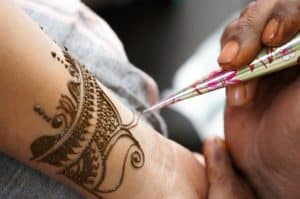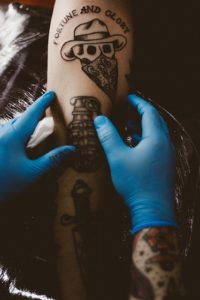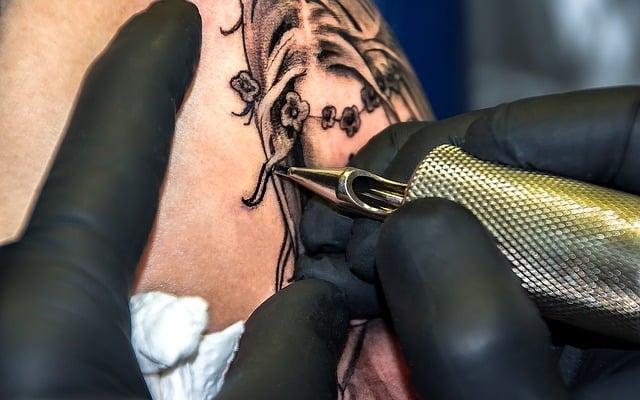Since tattoos are permanent, how are tattoo artists able to practice their craft, especially if they are new to the field? While it might be possible, it is not advised to immediately start applying ink to friends and family members.
There are several other ways that artists can perfect their craft, all of which are much better options. With this list, the possibilities are endless for tattoo artists who are looking to learn the art of tattooing!
Ways tattoo artists can practice the art of tattooing:
Get a notebook. First, start out drawing and sketching on paper. Begin with a pencil so you can erase. Then, move on to using a pen, which can’t be removed. Practice drawing different designs and styles of artwork. Requests from future clients will vary, so make sure you are versatile from the beginning. Once you feel more confident with this, you can move on to trying other options.
Practice (with a marker or Henna ink) on a friend. If you have a willing participant, try using a fine-tip marker to create a new design for them. If your friend isn’t satisfied with your artwork, marker can be removed from skin with rubbing alcohol. Once you’ve used a marker, you 
Grab a piece of fruit. Not for a snack, but to use as practice! Like the human body, fruits have curves and are not flat. Many artists try out their new tattoo equipment for the first time on fruits. Oranges, grapefruits, and honeydew melons are all great choices. You may want to try several different fruits to see which one you prefer. They can really be great options to those just starting out!
Use synthetic skin. Tattoo practice skin can be purchased online in individual sheets, booklets, and even in the shape of body parts such as hands and feet. While it is not identical to real skin, it has many similarities and reacts to a tattoo needle much the same. It is great for working on your steadiness, and perfecting clean lines and shading.
Consider using pig skin. Although some new artists aren’t interested in using pig skin because it can be stinky and hard to work with, it can still be a good option. It is also very similar to human skin. Pig skin can be a great way to practice controlling your needle depth: It is very important that tattoo needles go deep enough to create a permanent design, but not so deep that damage to the skin could occur. Pig skin can be purchased, but many artists seek out local butchers for free skin.
Tattoo yourself. Once you’ve gained more confidence with some of the above methods, you may feel comfortable practicing on your own skin. Often, new artists will choose inconspicuous locations on their body when they are just beginning. When you practice on yourself, you’re able to really get a feel for what your future clients will go through when you’re tattooing them. It’ll be an honor to be able to forever wear your “first” real piece of artwork!
Tattoo friends! Next, you’ll want to find a friend or family member who is interested in receiving a permanent tattoo from you! Many new tattoo artists offer their first tattoos for free or cheap, as they are still learning. This experience will be unique and will feel very different from tattooing on fruit and synthetic skin. While you may be extremely nervous practicing your art on someone else, tattooing a real person is essential to your career in tattooing.
Never stop practicing. It is important to note that continuing to learn/practice is essential to a successful career in tattooing. This career requires dedication to the art, extreme focus, and the realization that you’re never finished learning! So, keep on practicing! Continue to work hard to master the art of tattooing.
Can you be a good tattoo artist if you can’t draw?
Many tattoo artists disagree on if a tattoo artist can be successful without the ability to draw. Some believe it is essential to the craft, while others believe you can find success without a natural artistic ability.
It is possible to be a decent tattoo artist without being able to draw, but you will be faced with many challenges. You may feel limited or even inferior to your coworkers, but a career in this field is still possible.

If you simply cannot draw but are determined to have a career in tattooing, you will probably want to identify yourself as a “flash artist.” Flash art images are usually drawn by someone else, found online, or are in printed in large books at tattoo shops. The images are already created, and the artist transfers a stencil of the image onto skin in order to outline the tattoo.
Stencils can be a big help when tattooing, but sometimes the image fades from the skin before the tattoo is completed. In this case, you would either need to reapply the stencil or do your best at completing the tattoo freehand (which may or may not turn out well).
Unfortunately, the road an un-artistic tattoo artist travels can be littered with many roadblocks and challenges.
If you feel that you are not good at drawing but still want to be a tattoo artist, there are things you can do to improve your artistic ability. Although it may not come naturally to you, you can still work on the art and improve from where you started.
While practice doesn’t always make perfect, practice does make improvement! Don’t give up on drawing, even if it is a huge challenge for you.
Here are a few steps you can take to improve your drawing:
Study artwork from other artists. Try to copy what they’ve done. Draw their lines and shade where they have shaded.
Once you’ve gotten better at copying artwork, try to draw your own images. Sketch everyday objects around you. Draw a bowl, your cat, your toothbrush holder. You may even want to consider drawing items from nature. Draw anything and everything! Continue to draw and try to fill up a sketchbook.
If you’re still feeling stumped and don’t know where to turn, take a drawing class. Learn from your instructor and the classmates around you.
Art instructors can often provide helpful advice on how to deal with your specific areas of struggle.
Additionally, there are many great online resources and videos that can be very helpful to a budding artist.
Most importantly, if becoming a tattoo artist is a true dream for you, don’t give up on learning how to draw. You can learn how to do something and do it well, even if you don’t consider yourself a “natural.”
The possibilities for your career could be endless, if you’re willing to work to overcome the obstacles. There is truly no limit on what you could accomplish!

